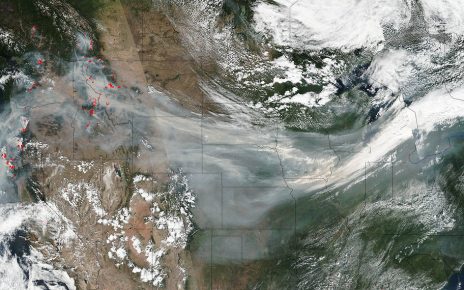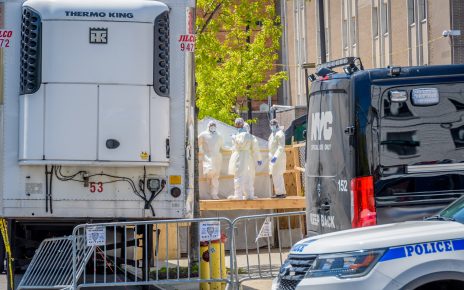The mud on Roberts Bank at the southern end of the Fraser River Delta in British Columbia is deep—and smelly. Exposed at low tide, it ranges for kilometers, and looks devoid of life. But across some sections, sunlight reflects with a slightly greenish luminescence. Those places are where you see flocks of plump little brown-and-white western sandpipers (Calidris mauri), and they are slurping up the shimmering material with their bristly tongue. They are eating a biofilm, a goo only a few millimeters thick that coats the surface of the mudflat and plays a key role in making these ecosystems among the most biologically productive in the world. That slime, produced by microbes, is also crucial to migratory shorebirds’ survival.
During migration, shorebirds may fly hundreds or thousands of kilometers without stopping, arriving to refuel en masse at a relatively small number of mudflats around the world. The stops need to provide the birds with enough food to recover from the previous leg of their journey—and the right kind of sustenance to sustain them for the next one. The loss or degradation of one of these stopovers can mean disaster for an entire species.
The losses are already happening. Along the Yellow Sea, between China and North and South Korea, the mudflats have shrunk by more than 65 percent in recent decades. If the mudflats continue to decline at current rates, three migratory species may reach endangered levels by 2026. In Canada, the Roberts Bank mudflat is potentially at risk from a proposed addition to an offshore container terminal. The terminal would not destroy the mudflat directly but could alter water salinity, upsetting the balance of its ecosystem—one that supports more than a million migratory birds during three weeks in April and May, along with a wide array of invertebrates, fish and other birds year round.
A significant part a mudflat’s biological productivity comes from the microbes living on its surface. “You take away the microbes from the mudflat, and the whole system collapses,” says Peter Beninger, a professor emeritus of marine biology at the University of Nantes in France. “You just have wet sand.”
A key factor in the microbes’ success on mudflats is that they live together in neighborhoods: the biofilms. These goos are made up of a congregation of microbes attached to a surface and living in a self-created substance consisting mostly of water and polysaccharides (a type of carbohydrate). Biofilms come in an array of sizes and can be found almost anywhere. They form in pipes, in water systems, on living organisms—the first biofilm discovered was on a person’s teeth—and, of course, on mud.
The engineers of mudflat biofilms are single-celled photosynthesizing organisms called diatoms. These algae live throughout the oceans—and most other damp places—and may conduct up to about a quarter of the photosynthesis in the world. Diatoms may release 70 percent of their photosynthetic production as goopy extracellular polymeric substances (EPS)—the glue of the biofilm neighborhood. EPS not only holds together the organisms (diatoms, bacteria, teeny animals) but also the materials they need to survive: external DNA, proteins, enzymes, nucleic acids, lipids and various dissolved compounds.
Living in close proximity has many advantages. Bacteria communicate via chemicals, which would be hard to do if the neighbors were too far away. Enzymes, such as those used to digest food, persist in the EPS and can be reused by others. EPS functions as grocery store, community tool chest and recycling center.
The biofilm is, in turn, a food bank for an array of animals—from worms and crabs to fish and birds. Many years of research on biofilm and migratory shorebirds at Roberts Bank and other areas illustrate the covert yet vital role that the slime plays in the ecosystem.
Biofilm is ideal migratory bird food. It is easy to eat—no hunting around for elusive prey—and contains an array of lipids (a group of compounds that includes fats). Lipids are lighter and more energy-dense than proteins or carbohydrates, which are ideal fuel for long, nonstop flights. Certain kinds of lipids, such as the well-known omega-3s, are essential fatty acids. They are anti-inflammatory and help transport energy into flight muscles. And one of them, DHA, aids spatial navigation—a necessity for birds flying on long transits. Not many organisms produce these essential fatty acids. Michael Arts, a professor at Ryerson University in Ontario, says that diatoms and other marine algae “are really the biggest factories on this planet.”
The quality and quantity of essential fatty acids created by the mudflat diatoms varies throughout the year. The Roberts Bank diatoms produce a big pulse of lipids, including essential fatty acids, during April and May. The reason for that pulse appears to be stress from the influx of fresh water as spring snowmelt fills the Fraser River. That increase coincides with the arrival of sandpipers, and it provides them with appropriate fuel for the 1,000-kilometer hop to their next stopover at the Stikine River in Alaska.
The importance of fatty acids and lipids for migratory bird success is a crucial discovery. “It is imperative that [long-distance migrating] birds find a fatty acid pulse somewhere before their nonstop legs of that migration,” says Patricia Baird, a research associate at the Center for Wildlife Ecology at Simon Fraser University in British Columbia. “The world has a shadow wave moving through it,” says Bob Elner, a scientist emeritus at Environment and Climate Change Canada: a “lipid pathway” that the birds are following. Knowing about that pathway can aid conservation efforts.
At Roberts Bank, the biofilm, its lipids and the birds that need them are at risk from the proposed terminal because of potential changes in salinity, which can alter the ecosystem in a variety of ways: changing the suite of diatoms living there or impacting the fresh-water-induced fatty acid pulse. As much as 42 to 64 percent of the global population of western sandpipers stop at Roberts Bank, favoring it over other Fraser River mudflats. Scientific study on exactly how the system works is ongoing. “If approximately half the world’s population of pandas or rhinos used a single field and largely ignored the surrounding fields, there would be a strong need to understand what makes that field unique—and to protect it,” says Catherine Jardine of Bird Studies Canada. A decision on the fate of the terminal is due later this year.
The research at Roberts Bank shows that obvious problems such as pollution or filling in mudflats to create buildable land are not the only way stopover points can be destroyed or compromised. Climate change is also a looming threat—and not just because of sea-level rise. Diatoms and other algae that make essential fatty acids produce fewer of them as the water warms. Those impacts would reverberate all the way up the food web to humans, who get the bulk of their DHA from fish. An analysis of DHA levels using different climate models found that global availability of the essential fatty acid could decrease by 10 to 58 percent by 2100. “We need to start thinking about conserving animals and spaces that are rich producers of essential fatty acids,” Arts notes, “because of the fact that they are so patchily distributed, and they’re under tremendous threat.”
It’s time, Elner adds, for a “new realization of the value of mud.”




